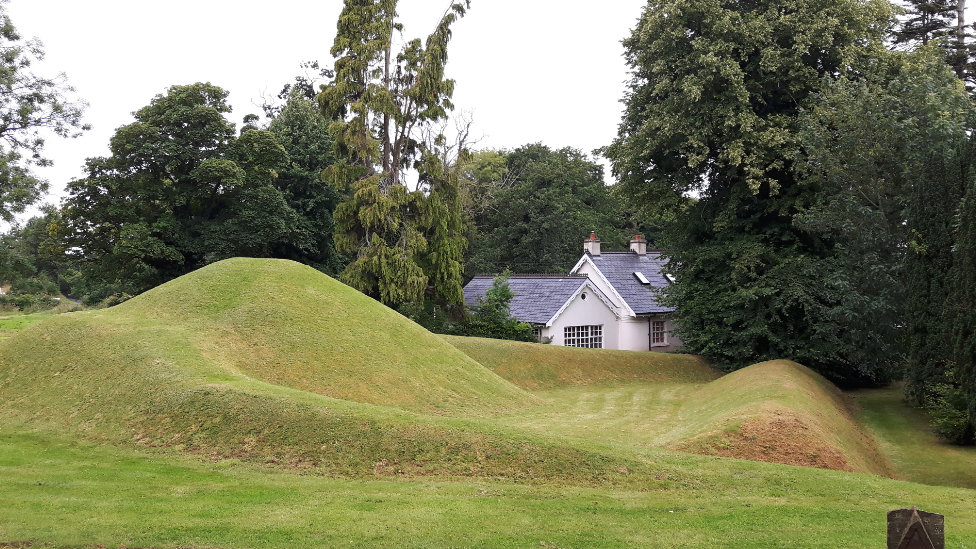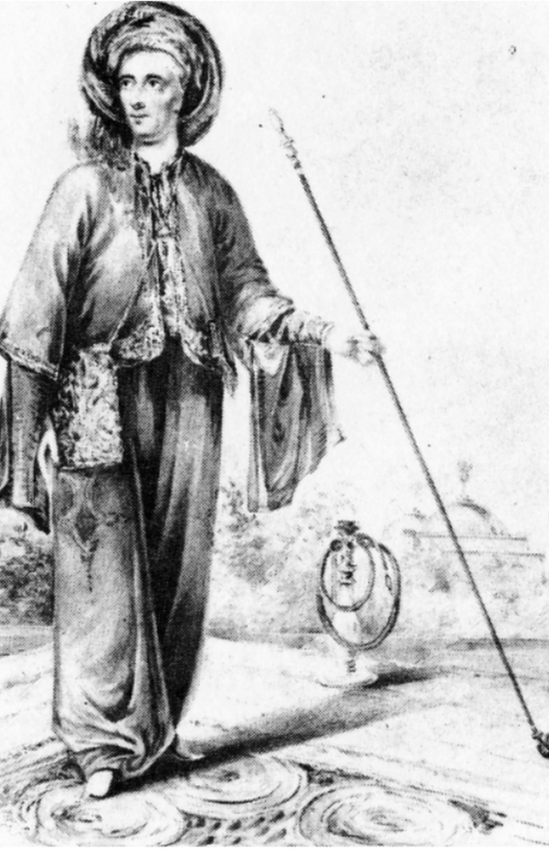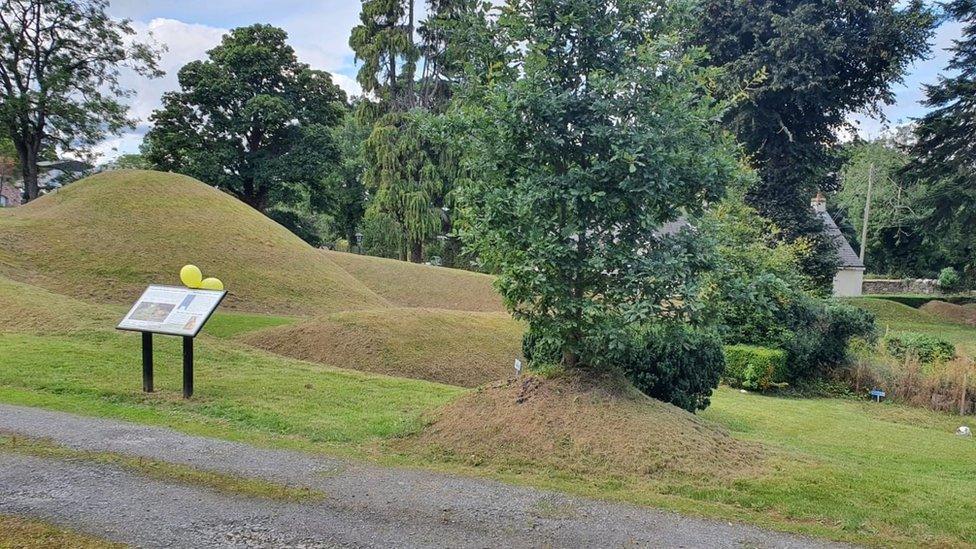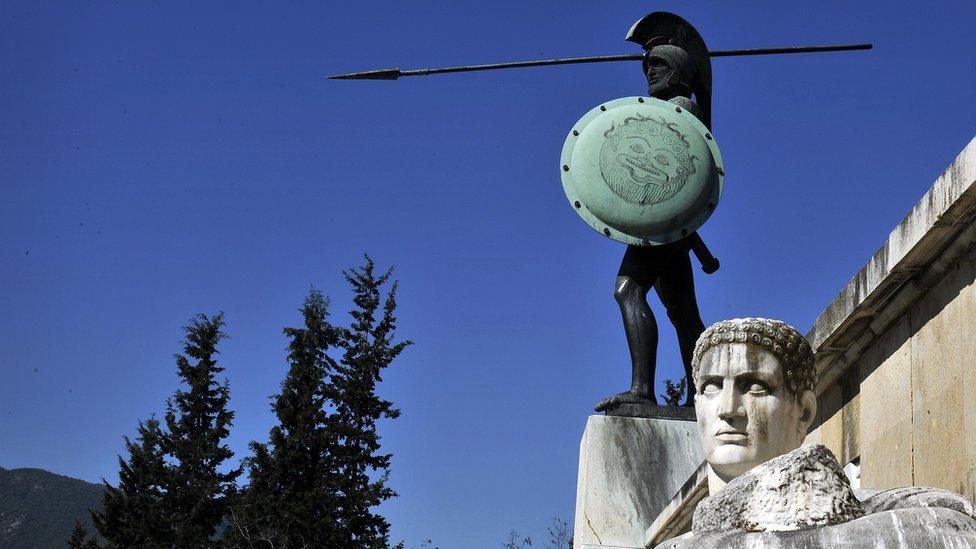Kilwarlin Moravian Church and its link to ancient Greece
- Published

The battlefield gardens were a gift from the Greek patriot, Basil Patras Zula
In the shade of the trees in a little County Down churchyard lies a curious reminder of classical antiquity.
A remarkable set of earthworks at Kilwarlin Moravian Church was laid out as a tribute to the Greek heroes of the Battle of Thermopylae.
The landscaping project was carried out in the 1840s by the Rev Basil Zula, a Greek patriot.
Zula was minister at the church and is said to have come up with the idea for the garden partly to provide work for his impoverished congregation.
Basil Patras Zula was an officer in the Greek army, a mysterious man whose story was investigated by historian Rachael Garrett.
She was employed as a researcher on the lottery-funded Finding Zula's Hollow project, which examined the life of the minister and his unlikely earthworks.
"People were intrigued about his past," she says. "It seems to be so unusual and unique."

Basil Patras Zula was a Greek patriot

Zula left Greece during the War of Independence from the Ottoman Empire.
The reasons given are many and varied. Some say the Ottoman Vizier Ali Pasha put a price on his head, others that he became disgusted with Greek reprisals on Turkish soldiers.
Zula travelled to Ireland in 1828 where he met and married Ann Linfoot, a member of the Moravian Church.
The church originated in Bohemia in the 15th Century - it is now a worldwide Christian church and is best known in Northern Ireland for the Moravian settlement at Gracehill in County Antrim.
Battlefield garden
The ex-soldier joined the church and was ordained as a Moravian minister. The couple found themselves in the tiny village of Kilwarlin, near Hillsborough.
Zula rebuilt the church and his congregation grew.
And in 1841, next to the little church he built his battlefield garden - a landscaped representation of the area where the Battle of Thermopylae was fought.
Local lore has it that the minister feared Ottoman assassins were still on his trail and may even have faked his own death.
"There were stories that maybe his coffin was full of stones to escape Turkish agents who had come to get him," says Ms Garrett.

Zula is said to have employed impoverished people in the landscaping of the garden
Helen McVeigh is a a teacher of classical Greek and was born into the Moravian Church.
She can recall visiting Zula's garden as a child.
"I remember going there with school trips and I remember rolling down the hills," she says.
"The story of Thermopylae is a story of bravery, heroism and it's also a story of betrayal because the Spartans were betrayed by one of their own," Ms Mc Veigh adds.
She explains that the stories of ancient Greece "are exotic but they are timeless, they can apply to us today".


A statue of the famous Spartan king and warrior Leonidas now watches over the hot spring of Thermopylae
Battle of Thermopylae
One of the most celebrated military actions in ancient Greece, in 480 BC, a vastly outnumbered army of Greeks took on an invading army of Persians led by King Xerxes I.
The actions of the Spartan King Leonidas and his Greek army of 7,000 men in holding back the Persian army of between 120,000 and 300,000 at the Pass of Thermopylae are a revered example of self-sacrifice for the greater good.
Despite their best efforts, the Greeks were defeated, Leonidas's dead body was dismembered and Xerxes's army destroyed Athens.
Spool forward 2,300 years or so and the early 19th Century Greeks were engaged in a war of national liberation from the Ottoman Empire.
It was a cause taken up by romantics across the continent of Europe. Known as the philhellenic movement, its members included the English poet Lord Byron.

Dr Livingstone Thompson, the current minister at Kilwarlin, is from Jamaica.
He first visited the garden when he came to Ireland in 1999.
Rev Thompson thinks useful lessons can be drawn from Zula's experience.
"I wondered about how that story of a refugee contributed to the local community and might connect with the experience of refugees in Northern Ireland," he says.
The Moravian minister has great hopes for the Thermopylae garden.
"The garden is better known than the church itself," he adds.
He would like to develop a master plan that would allow greater access to the public.
Then even more people could share in the remarkable life story of Basil Zula and his horticultural legacy.
Related topics
- Published28 November 2022